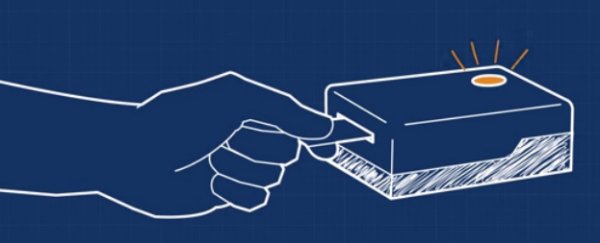A student team has developed a super-sensitive biosensor that can rapidly detect small amounts DNA from the Ebola virus, and other disease-causing agents.
The nanomachine is so small that it could one day be used to diagnose disease simply by putting a blood sample into your smart phone or a portable machine. If the virus being searched for is present, the nanosensors will light up.
Team EchiDNA involved students from the University of New South Wales (UNSW), and was the first Australian team to enter the prestigious Harvard University Biomod Competition - a biomolecular design competition for undergraduates.
They've now beaten 33 other teams to take out the Grand Prize for their invention.
Their multi-faceted sensor is more accurate and sensitive than others on the market, and was inspired by the cooperative behaviour we see in the natural world - such as the behaviour that helps cells and ants work together as a team.
Their nano-sized sensor works sort of like a light switch - it turns on and glows like a beacon when it comes into contact with a specific strand of DNA.
The machine has been designed to detect Ebola, but it could look for DNA from anything - such as the kind that's found in cancer cells, HIV, bacterium or tuberculosis.
But, unlike other nanosensors, which rely on one biomarker to signal the presence of the DNA, the team developed a whole knotted ring of markers that light up more strongly when they detect a signal, which leads to better sensitivity and less false positives.
"Our concept is inspired by the way biology works and could provide a quicker and cheaper method of alerting scientists and doctors to the presence of disease," said Lawrence Lee, a molecular biologist at the Victor Chang Cardiac Research Institute who supervised the student team, in a press release.
"Further down the track we would like to have a sensor that is so sophisticated you can test for bacteria or viruses by plugging a blood sample into your mobile phone."
The device is also cheap and so small that it can be used easily anywhere in the world to speed up diagnosis. Currently doctors need to use bulky equipment and it can take hours, if not days, to confirm the presence of bacteria in a sample.
The students now need to use their nanosensors to detect real Ebola virus DNA to make sure that the biomarkers are sensitive enough - they can then fine-tune them and tweak them to light up in the presence of other diseases.
Robert Oppenheimer, the team leader and a science student at UNSW, told the Daily Telegraph: "It's extremely rare for science students to make a genuine contribution in the lab and we actually are."
Jon Beregut, another UNSW team mate, was formerly a production designer before he studied science, and he helped create the graphics and video that the team presented to the Harvard Biomod panel.
"Dropping everything and leaving my product design career was one of the best decisions I've made in my life. Not because I hated my job, far from it, but because entering this field with my set of skills has opened up countless opportunities to excel. And I'm not just designing stuff for science, actually using my design background to DO science," said Berengut.
"Our results demonstrate what can be achieved when you stick a few highly motivated students together in a lab for three intensive months. This experience has been one of the most valuable of my undergraduate career."
Find out more about their biosensor in the video below (which also won the YouTube video prize at the competition):
Love science? Find out more about studying with the game-changing researchers at UNSW.
Source: UNSW, Daily Telegraph
